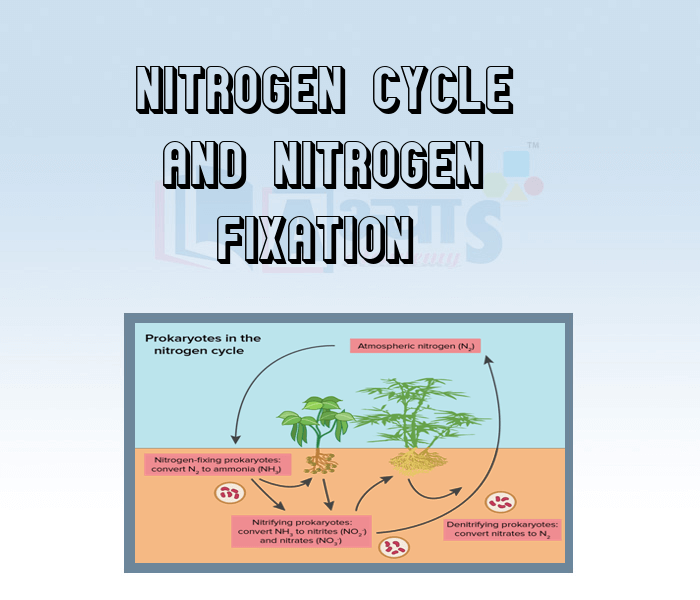Nitrogen Cycle and Nitrogen Fixation










Nitrogen Cycle and Nitrogen Fixation
Nitrogen Cycle:
Air contains 78% nitrogen in atmosphere. Water bodies also contain nitrogen. Nitrogen is an essential component of proteins, Vitamins and nucleic acids present in all living things. It is a natural cyclic in which atmospheric nitrogen enters the soil and becomes a part of living organisms, organisms, before returning to the atmosphere. It has three steps:
Nitrogen Fixation:
Nitrogen fixation is the process by which free atmospheric nitrogen is converted into nitrogen compounds. It is of two types:
a. Atmospheric Nitrogen Fixation: during lightning in the sky when temperature is high, the nitrogen gas present in the atmosphere reacts with oxygen to produce oxides of nitrogen which bets dissolved in rainwater to form nitric acids.
b. Biological Nitrogen Fixation: atmospheric nitrogen is converted into nitrogen compounds by living organisms. Nitrogen fixing bacteria like Rhizobium and Clostridium which lives in the root nodules of leguminous plants converts atmospheric nitrogen into nitrates.
1. Nitrogen assimilation: the conversion of inorganic compounds into organic compounds is called nitrogen assimilation. The plants absorb nitrogenous compound from the soil and water and convert them into plant proteins.
2. Denitrification: the conversion of nitrate salt which is present in the soil to free nitrogen gas is called Denitrification. It is carried out in the soil by bacteria called Psedomonas.
Haber's process involves combining nitrogen and hydrogen to yield | |||
| Right Option : C | |||
| View Explanation | |||
Which of the following are correct : (a) Air contains 78% nitrogen in atmosphere. (b) Nitrogen fixation is the process by which free atmospheric nitrogen is converted into nitrogen compounds. | |||
| Right Option : C | |||
| View Explanation | |||
Which of the following are correct : (a) Atmospheric nitrogen is converted into nitrogen compounds by living organisms. (b) Nitrogen fixing bacteria like Rhizobium and Clostridium which lives in the root nodules of leguminous plants converts atmospheric nitrogen into nitrates. (c) The conversion of nitrate salt which is present in the soil to free nitrogen gas is called Denitrification. | |||
| Right Option : D | |||
| View Explanation | |||
Students / Parents Reviews [10]
Abhyas is a complete education Institute. Here extreme care is taken by teacher with the help of regular exam. Extra classes also conducted by the institute, if the student is weak.

Om Umang
10thA marvelous experience with Abhyas. I am glad to share that my ward has achieved more than enough at the Ambala ABHYAS centre. Years have passed on and more and more he has gained. May the centre flourish and develop day by day by the grace of God.

Archit Segal
7thOne of the best institutes to develope a child interest in studies.Provides SST and English knowledge also unlike other institutes. Teachers are co operative and friendly online tests andPPT develope practical knowledge also.

Aman Kumar Shrivastava
10thIt has a great methodology. Students here can get analysis to their test quickly.We can learn easily through PPTs and the testing methods are good. We know that where we have to practice

Barkha Arora
10thMy experience with Abhyas is very good. I have learnt many things here like vedic maths and reasoning also. Teachers here first take our doubts and then there are assignments to verify our weak points.

Shivam Rana
7thBeing a parent, I saw my daughter improvement in her studies by seeing a good result in all day to day compititive exam TMO, NSO, IEO etc and as well as studies. I have got a fruitful result from my daughter.

Prisha Gupta
8thIt was a good experience with Abhyas Academy. I even faced problems in starting but slowly and steadily overcomed. Especially reasoning classes helped me a lot.

Cheshta
10thI have spent a wonderful time in Abhyas academy. It has made my reasoning more apt, English more stronger and Maths an interesting subject for me. It has given me a habbit of self studying

Yatharthi Sharma
10thAbout Abhyas metholodology the teachers are very nice and hardworking toward students.The Centre Head Mrs Anu Sethi is also a brilliant teacher.Abhyas has taught me how to overcome problems and has always taken my doubts and suppoeted me.

Shreya Shrivastava
8thAbhyas Methodology is very good. It is based on according to student and each child manages accordingly to its properly. Methodology has improved the abilities of students to shine them in future.
